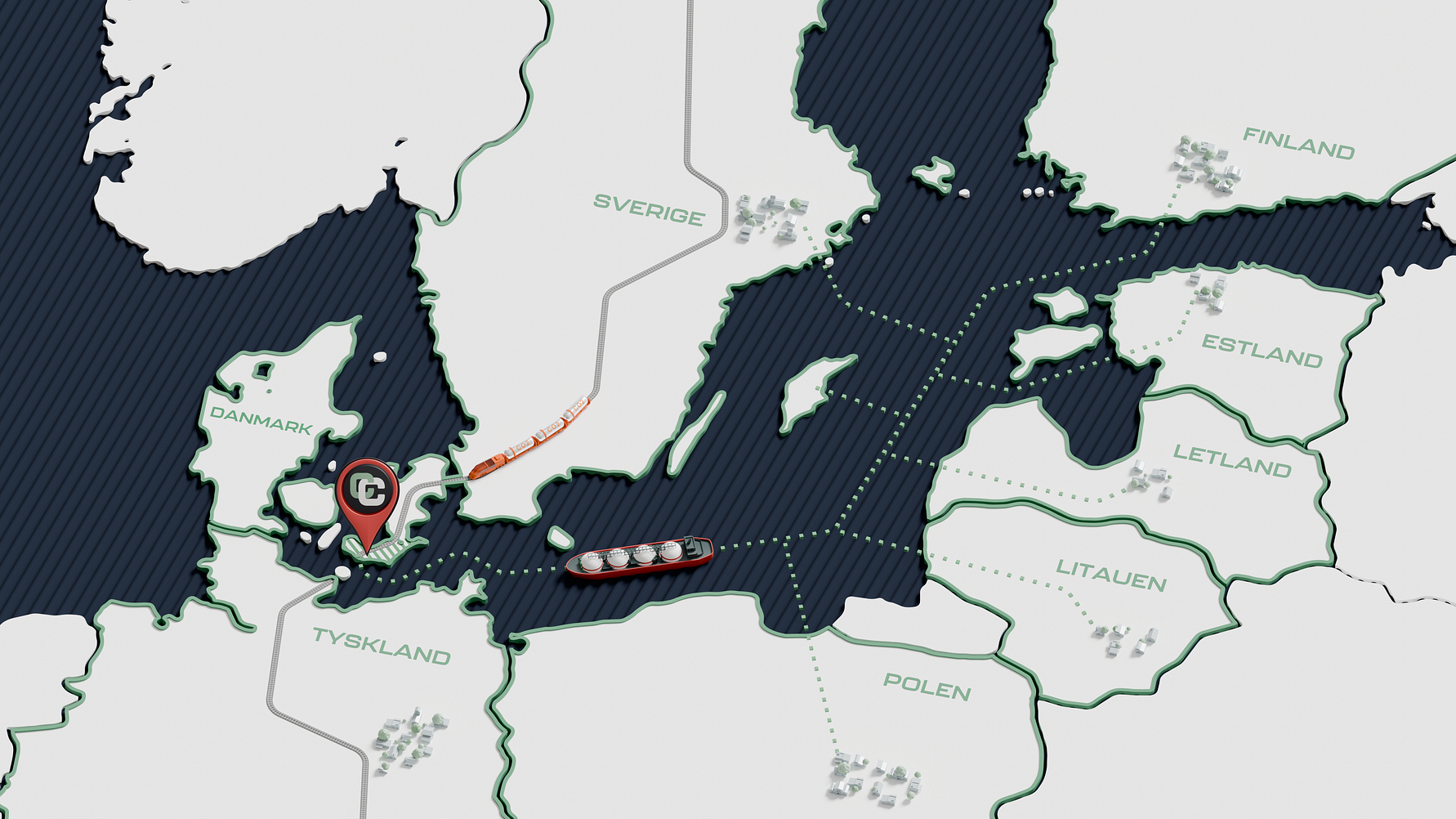CarbonCuts awarded exploration license on Lolland for CO2 storage project ‘Ruby’

[in English below]
Kgs. Lyngby, 20 June, 2024: The Danish authorities have granted CarbonCuts a license to investigate the possibility of a future CO2 storage facility on Lolland. CarbonCuts expects to begin storage in 2030 or earlier if the studies go as planned. The project that will be located near Rødby is named “Ruby”.
The Danish Minister for Climate, Energy and Utilities Lars Aagaard has today awarded CarbonCuts an exploration license on the recommendation of the Danish Energy Agency. The state-owned Nordsøfonden participates as a partner in all licenses.
The license allows CarbonCuts to carry out a comprehensive multi-year exploration program to ensure that the plans for a permanent CO2 storage facility in the Rødby structure meet all geological, environmental, safety and financial criteria. A final storage license will only be obtained once the extensive subsurface investigations have been satisfactorily completed and all license criteria have been met. Then CarbonCut’s owners together with Nordsøfonden can make the final investment decision to establish the CO2 storage facility.
Ken Wesnæs, CEO of CarbonCuts, says:“This is a great day for us. We are proud to be awarded the exploration license for ‘Project Ruby’, which the team has been working hard on for a long time. The local authorities and companies on Lolland have all welcomed us and our vision to contribute to the green transition. We are excited to take on the task and to implement the work program we have set out in the application to the highest standards throughout.”
Euan Shirlaw, CEO of BlueNord, the company that owns CarbonCuts, said: “We are proud of CarbonCuts’ capabilities and progress. This license is the first major milestone in the realization of the Ruby Project, which will contribute to Denmark’s carbon storage ambitions and the entire climate effort. We look forward to supporting CarbonCut’s ambition to develop and implement Ruby as an important part of BlueNord’s energy transition strategy.”
Project Ruby: Ideal combination of geology and geography
The project is now moving from the drawing board to real action, and the first years will be spent investigating and analyzing the subsurface and infrastructure design in detail. As early as winter 2025, CarbonCuts plans to conduct 3D seismic surveys to ensure that the Red City structure meets all criteria to establish and operate a facility safely and sustainably over many years. With the outlined plan, CarbonCuts expects to begin storage in 2030 or earlier with approximately 1 million tons annually.
The project’s location close to Rødbyhavn emphasizes the international potential. “We are looking at different scenarios for transportation and import of CO2 to Rødby, including receiving CO2 directly in Rødby by sea with ships. This opens the door for a broad spectrum of cooperation with other ports in Denmark and countries around the Baltic Sea that have limited possibilities to store CO2 themselves,” says Wesnæs. The approach ensures that CarbonCuts can play a central role in the entire region’s climate efforts.
Engaging with citizens
CarbonCuts places great emphasis on being able to contribute to local green growth and collaboration across sectors on Lolland. Local anchoring and early dialog with the citizens in the Rødby area are crucial to the success of the project. “We have a strong desire for an open and ongoing dialog with the local community. Therefore, as a first initiative, we will also be inviting citizens to meetings at the end of August 2024, where we will inform and engage everyone about the project’s progress and importance for the area,” says Wesnæs.
More information
Read the Danish Energy Agency’s press release
Read the Ministry of Climate, Energy and Utilities’ press release
About the license
The licenses to explore the subsoil are initially issued for up to four years with the possibility of extension for a total of ten years. If the area meets all environmental requirements and is found suitable for storage of CO2, CarbonCuts will have priority to apply for a storage license, which can last up to 30 years. Thereafter, the project will enter a decommissioning phase where the storage facility will be closed and the CO2 in the subsurface will be continuously monitored. Activities in the exploration phase and the specific storage projects, such as seismic surveys and deep drilling, are covered by the Environmental Assessment Act and must undergo either an environmental and habitat screening or a full environmental impact assessment (EIA).
About the Rødby structure
The Rødby structure is a 20 km long and 10 km wide underground formation on Lolland that lies more than 1,000 m below the surface. The structure has been designated by the Danish state for its geological suitability for CO2 storage. It is CarbonCut’s ambition to permanently store captured CO2 from industry in Denmark and nearby EU countries in this structure.
About CCS
In collaboration with 17 other players in the CCS sector, CarbonCuts has just published a new joint knowledge portal on CO2 capture and storage – on the website www.co2idybden.dk . Here, citizens and other interested parties can get more information about the climate technology CCS, which many Danes do not yet know much about.
PRESS RELEASE
CarbonCuts awarded exploration license on Lolland for onshore CO2 storage Project ‘Ruby’
Kgs. Lyngby, June 20, 2024 – The Danish authorities have awarded CarbonCuts a license to explore the possibility of a future onshore CO2 storage facility on the island of Lolland. CarbonCuts expects to begin storage in 2030 or earlier following a successful exploration plan. The project, located near the town of Rødby, has been named ´Ruby´.
Climate, Energy, and Utilities Minister Lars Aagaard has today awarded CarbonCuts an exploration license based on a recommendation from the Danish Energy Agency. The state-owned Nordsøfonden is participating as a partner in all licenses.
The granted license allows CarbonCuts to conduct a comprehensive multi-year exploration programme to ensure that the plans to establish a permanent onshore CO2 storage facility in the geological formation at Rødby meet all geological, environmental, safety, and financial criteria. The final storage license will be obtained only after satisfactory completion of the extensive subsurface investigations and once all license criteria are met. Subsequently, CarbonCuts’ owners, BlueNord together with Nordsøfonden, can make the final investment decision (FID) to establish the CO2 storage facility.
Ken Wesnæs, CEO of CarbonCuts, states: “This is a fantastic day for us. We are proud to be awarded the exploration license for ‘Project Ruby’, which the team has worked hard on for a long time. The local authorities and businesses on Lolland have all welcomed us and our vision to contribute to the green transition. We look forward to taking on the task and executing the work program we presented in the application to the highest standards all around.”
Euan Shirlaw, BlueNord CEO, comments: “We are proud of CarbonCuts’ capabilities and progress. The exploration license is the first major milestone in the realisation of the Ruby Project, which will contribute to Denmark’s CO2 storage ambitions and national climate efforts. We look forward to supporting CarbonCuts’ ambition to develop and implement Ruby as an important part of BlueNord’s energy transition strategy.”
Project Ruby: Ideal combination of geology and geography
The project is now moving from the drawing board to real action, and the first few years will be spent exploring and analyzing the subsurface and infrastructure design in detail. As early as the winter of 2025, CarbonCuts plans to conduct 3D seismic surveys to ensure that the Rødby formation meets all criteria for establishing and operating a facility safely and sustainably over many years. CarbonCuts expects, with the outlined plan, to be able to begin storage in 2030 or earlier, aiming for approximately 1 million tons annually.
The project’s location near Rødbyhavn emphasizes its international potential. “We are looking at different scenarios for the transport and import of CO2 to Rødby, including receiving CO2 directly at Rødby by sea via ships. This opens the door for a wide range of cooperation with other ports in Denmark and countries around the Baltic Sea that have limited options for CO2 storage,” says Wesnæs. This approach ensures that CarbonCuts can play a central role in the region’s climate efforts.
Seeking dialog with residents
CarbonCuts places great emphasis on contributing to local green growth and cross-sector collaboration on Lolland. Local engagement and early dialog with the Rødby residents are crucial for the project’s success. “We have a strong desire for an open and ongoing dialog with the local community. Therefore, as a first initiative, we will be inviting residents to community meetings at the end of August 2024, where we plan to inform and engage the community about the project’s progress and significance for the area,” says Wesnæs.
More Information
Press release from the Danish Energy Agency (in Danish)
Press release from the Danish Ministry of Climate, Energy, and Utilities (in Danish)
About the license
- The licenses to explore the subsurface are initially granted for up to four years with the possibility of extension up to a total of ten years. If the area meets all environmental requirements and is deemed suitable for CO2 storage, CarbonCuts has the preferential right to apply for a storage permit, which can last for up to 30 years. Subsequently, the project will transition to a decommissioning phase, where the storage site is closed, and the CO2 in the subsurface is continuously monitored. Activities in the exploration phase and specific storage projects such as seismic surveys and deep drilling are covered by the environmental assessment law and must undergo either an environmental and habitat screening or a full environmental impact assessment (EIA).
About the Rødby formation
- The Rødby formation is a 20 km long and 10 km wide underground formation on Lolland, more than 1,000 meters below the surface. The structure has been designated by the Danish state for its geological suitability for CO2 storage. It is CarbonCuts’ ambition to permanently store captured CO2 from industry in Denmark and emitters from nearby EU countries in this structure
About CCS
- In collaboration with 17 other actors in the CCS sector, CarbonCuts has just launched a new joint knowledge portal on CO2 capture and storage on the website www.co2idybden.dk. Here, anyone can find more information and dive deeper into CCS, a climate technology that many Danes are still not very familiar with.


